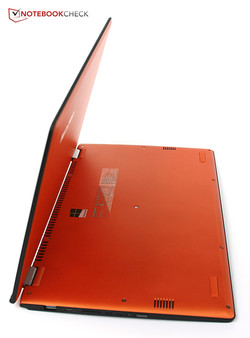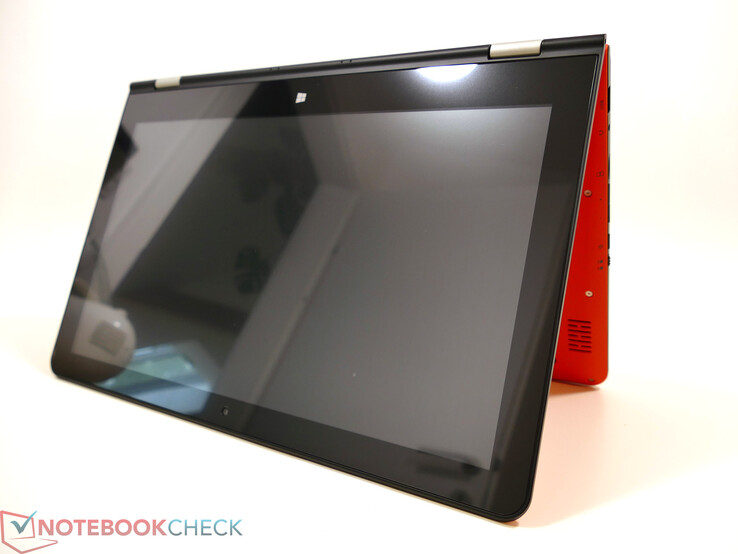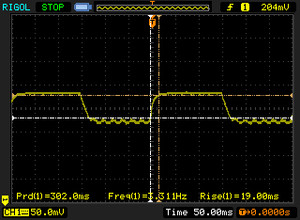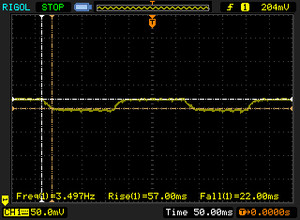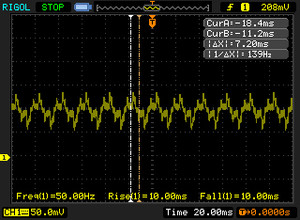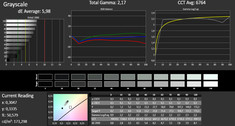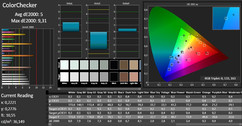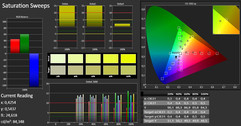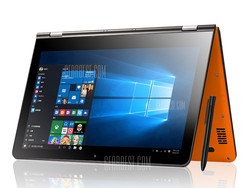VOYO VBook V3 Convertible Review

For the original German review, see here.
Undoubtedly, the thought of fusing the productivity of a laptop with the comfort of a tablet has a legitimate attraction. Unfortunately, the price threshold for devices of known manufacturers that feature corresponding equipment (screen diagonal, hardware) is comparatively high. Therefore, it is not surprising that an increasing number of offers from the Far East are infiltrating the market here. Lowest prices that are enhanced by limited special offers make it difficult for users to not give in to the temptation. However, caution is called for: Numerous, unknown suppliers are gathered on the various sales platforms, there are risks when paying for the goods (prepayment, credit card) and delivery times are uncertain, customs fees are normally due, and there is a lack of experience in terms of the durability of the devices, possible lack of certified control authorities, state of the received goods and ensuing warranty claims, etc. – are more than enough reasons for reservations.
Notwithstanding these, we ordered a device for a test and want to compare the hardware with those of known convertibles and 2-in-1s. Where do the supposed Chinese replicas stand compared with the originals that, by the way, usually also come from the land of the rising sun...
Case and Connectivity
Some readers might remember Lenovo's Yoga 2 13 with its striking orange outer shell. The fact that VOYO's V3 is available with a similar look is probably not a coincidence, but rather a deliberately borrowed plume from the original. Of course, configured with the latest and passively cooled Intel CPU, VOYO's device does not need vents. The device's build is impeccable; only the torsional robustness could be slightly higher. The feel of the orange-colored soft-touch finish on the outsides is a pleasure to touch.
The hinges allow rotating the screen by 360 degrees, but they do not keep the display firmly enough to prevent it from rocking. This is particularly annoying when using the device on the lap or on soft surfaces. It is possible to open the device, although any potential maintenance actions are prevented as all components are non-removable and even the battery has been glued in place.
The keyboard provides satisfactory feedback with a rather short drop. The touchpad recurrently got in the way while we typed. It responded when our palms touched it and moved the cursor. A corresponding detection is probably missing here. The touchpad itself is implemented as a ClickPad. It has a pleasant surface, but repeatedly caused problems when mechanical clicks were prompted. A comparatively large area simultaneously triggered a left and right click in the lower center. Therefore, we preferred using the touchscreen directly for inputting, which also remained inconspicuous in the test. The power button and additional hardware keys for volume control are on the left lateral edge, and they can also be used in the tablet mode. The keyboard is disabled in this setting.
The connectivity is satisfactory. We find a full-size USB port (right USB 3.0), a micro HDMI port and headphone jack on the rear areas of the lateral edges.
SD-Card Reader
VOYO's V3 features a micro-SD reader on its right. Theoretically, it can also be used for expanding the internal storage. We observed an average performance when copying image files from the storage to the device. However, the benchmark test via AS SSD that reads out the maximum possible write and read rates was rejected.
| SD Card Reader | |
| average JPG Copy Test (av. of 3 runs) | |
| Toshiba Satellite Radius 14 L40W-C-10Z | |
| HP x360 310 G1 | |
| VOYO VBook V3 | |
| Lenovo Yoga 300-11IBR | |
| Asus Zenbook UX360CA-FC060T | |
| maximum AS SSD Seq Read Test (1GB) | |
| Toshiba Satellite Radius 14 L40W-C-10Z | |
| HP x360 310 G1 | |
| Lenovo Yoga 300-11IBR | |
| Asus Zenbook UX360CA-FC060T | |
| VOYO VBook V3 | |
Wi-Fi Performance
The test for determining the maximum transmission rates of the installed Wi-Fi communication modules presented us with the device's first potential weakness. Even though we do not have rates from devices in a similar price range and all comparison devices are considerably more expensive, the outcome is disappointing.
| Networking | |
| iperf Server (receive) TCP 1 m | |
| Apple MacBook 12 (Early 2016) 1.1 GHz | |
| Acer Aspire Switch Alpha 12 SA5-271-70EQ | |
| Huawei MateBook m5-6Y54 | |
| HP Spectre x2 12-a001ng | |
| VOYO VBook V3 | |
| iperf Client (transmit) TCP 1 m | |
| Acer Aspire Switch Alpha 12 SA5-271-70EQ | |
| Huawei MateBook m5-6Y54 | |
| Apple MacBook 12 (Early 2016) 1.1 GHz | |
| HP Spectre x2 12-a001ng | |
| VOYO VBook V3 | |
Display
The screen's key specifications sound very promising on paper: Full HD IPS at a diagonal of 13.3 inches. However, our measurements present some weak points, for example, the brightness of 200 cd/m² that could be higher, particularly when using VOYO's device on the go in low light conditions. The color reproduction is still acceptable for a device from this price range, although it exhibits a visible greenish tint especially in white and bright gray tones.
According to our measurements, the device does not utilize PWM for controlling brightness, but it exhibits flickering in all brightness levels at a frequency of 50 Hz. We did not observe this in battery mode, and thus we strongly suspect that the power supply is responsible for this.
| |||||||||||||||||||||||||
Brightness Distribution: 72 %
Center on Battery: 195 cd/m²
Contrast: 813:1 (Black: 0.24 cd/m²)
ΔE ColorChecker Calman: 5 | ∀{0.5-29.43 Ø4.78}
ΔE Greyscale Calman: 5.98 | ∀{0.09-98 Ø5}
Gamma: 2.17
CCT: 6764 K
| VOYO VBook V3 Chi Mei N116HSE, IPS LED, 1920x1080, 13.3" | Asus Zenbook UX360CA-FC060T AUO B133HAN02.7, IPS with 72% NTSC, 1920x1080, 13.3" | HP x360 310 G1 Samsung SEC3953, TN, 1366x768, 11.6" | Toshiba Satellite Radius 14 L40W-C-10Z LG Display LP140WH8-TPK1, TN LED, 1366x768, 14" | Lenovo Yoga 300-11IBR AU Optronics B116XTN02.3, TN LED, 1366x768, 11.6" | |
|---|---|---|---|---|---|
| Screen | 16% | -84% | -35% | -44% | |
| Brightness middle (cd/m²) | 195 | 302 55% | 199 2% | 224 15% | 256 31% |
| Brightness (cd/m²) | 200 | 298 49% | 186 -7% | 209 5% | 242 21% |
| Brightness Distribution (%) | 72 | 90 25% | 76 6% | 84 17% | 89 24% |
| Black Level * (cd/m²) | 0.24 | 0.21 12% | 0.8 -233% | 0.37 -54% | 0.68 -183% |
| Contrast (:1) | 813 | 1438 77% | 249 -69% | 605 -26% | 376 -54% |
| Colorchecker dE 2000 * | 5 | 6.33 -27% | 11.92 -138% | 10.29 -106% | 8.87 -77% |
| Colorchecker dE 2000 max. * | 9.31 | 11.89 -28% | 20.52 -120% | 14.35 -54% | |
| Greyscale dE 2000 * | 5.98 | 8.13 -36% | 12.92 -116% | 11.82 -98% | 9.6 -61% |
| Gamma | 2.17 101% | 2.52 87% | 2.04 108% | 2.56 86% | 2.2 100% |
| CCT | 6764 96% | 6811 95% | 13589 48% | 12063 54% | 9857 66% |
| Color Space (Percent of AdobeRGB 1998) (%) | 60 | 36 | 36 | 35 | |
| Color Space (Percent of sRGB) (%) | 93 | 56 | 57 | 55 |
* ... smaller is better
Display Response Times
| ↔ Response Time Black to White | ||
|---|---|---|
| 40 ms ... rise ↗ and fall ↘ combined | ↗ 19 ms rise | |
| ↘ 21 ms fall | ||
| The screen shows slow response rates in our tests and will be unsatisfactory for gamers. In comparison, all tested devices range from 0.1 (minimum) to 240 (maximum) ms. » 97 % of all devices are better. This means that the measured response time is worse than the average of all tested devices (20.2 ms). | ||
| ↔ Response Time 50% Grey to 80% Grey | ||
| 49 ms ... rise ↗ and fall ↘ combined | ↗ 27 ms rise | |
| ↘ 22 ms fall | ||
| The screen shows slow response rates in our tests and will be unsatisfactory for gamers. In comparison, all tested devices range from 0.165 (minimum) to 636 (maximum) ms. » 84 % of all devices are better. This means that the measured response time is worse than the average of all tested devices (31.6 ms). | ||
Screen Flickering / PWM (Pulse-Width Modulation)
| Screen flickering / PWM not detected | |||
In comparison: 53 % of all tested devices do not use PWM to dim the display. If PWM was detected, an average of 8111 (minimum: 5 - maximum: 343500) Hz was measured. | |||
Performance
Equipped with Intel's x5-Z8300, VOYO's V3 can implement passive cooling. The benchmark comparison clearly illustrates that there are two performance categories for modern convertibles: The premium range based on Intel's Core m and Core i processors, and the entry-level with Atom and Celeron processors. VOYO's V3 belongs to the entry-level and delivers the expected performance. This means that in reality the device is predestined for basic tasks such as Internet browsing and light office works. More complex applications will often involve somewhat longer waiting times, and games with higher graphics requirements were not included in the intended use of the device.
Processor
System Performance
| PCMark 8 - Home Score Accelerated v2 | |
| Asus Zenbook UX360CA-FC060T | |
| Lenovo Yoga 300-11IBR | |
| HP x360 310 G1 | |
| VOYO VBook V3 | |
| PCMark 8 Home Score Accelerated v2 | 1352 points | |
Help | ||
Storage Device
| VOYO VBook V3 HD Graphics (Cherry Trail), Z8300, 64 GB eMMC Flash | Asus Zenbook UX360CA-FC060T HD Graphics 515, 6Y30, Lite-On CV1-8B128 | HP x360 310 G1 HD Graphics (Bay Trail), N3540, Toshiba MQ01ABF050 | Toshiba Satellite Radius 14 L40W-C-10Z HD Graphics 5500, 5015U, HGST Travelstar 5K1000 HTS541010A9E680 | Lenovo Yoga 300-11IBR HD Graphics (Braswell), N3050, Seagate ST500LM000 Solid State Hybrid Drive | |
|---|---|---|---|---|---|
| CrystalDiskMark 3.0 | 482% | -27% | -31% | -3% | |
| Read Seq (MB/s) | 148.4 | 497 235% | 99.5 -33% | 97.1 -35% | 118.9 -20% |
| Write Seq (MB/s) | 30.34 | 182.9 503% | 102.9 239% | 94.9 213% | 117.2 286% |
| Read 512 (MB/s) | 145.6 | 353 142% | 34.45 -76% | 32.3 -78% | 38.89 -73% |
| Write 512 (MB/s) | 28.88 | 144.1 399% | 42.7 48% | 37.5 30% | 76 163% |
| Read 4k (MB/s) | 9.91 | 31.89 222% | 0.439 -96% | 0.39 -96% | 0.474 -95% |
| Write 4k (MB/s) | 14.72 | 62 321% | 0.013 -100% | 0.958 -93% | 0.99 -93% |
| Read 4k QD32 (MB/s) | 15.5 | 207.7 1240% | 0.851 -95% | 0.796 -95% | 1.081 -93% |
| Write 4k QD32 (MB/s) | 14.76 | 131.8 793% | 0.033 -100% | 0.952 -94% | 0.724 -95% |
Graphics Card
| 3DMark 11 - 1280x720 Performance GPU | |
| Toshiba Satellite Radius 14 L40W-C-10Z | |
| Asus Zenbook UX360CA-FC060T | |
| Lenovo Yoga 300-11IBR | |
| VOYO VBook V3 | |
| HP x360 310 G1 | |
| 3DMark 11 Performance | 344 points | |
Help | ||
Emissions and Energy Management
Thanks to Intel's Atom CPU and a solid-state drive, we are dealing with an absolutely silent device. Developing heat is distributed over the components via a thermal pad and then discharged outward. This can result in very high surface temperatures during prolonged load. However, this will probably only be an exceptional case in everyday use.
Temperature
(-) The maximum temperature on the upper side is 54.8 °C / 131 F, compared to the average of 35.4 °C / 96 F, ranging from 19.6 to 60 °C for the class Convertible.
(-) The bottom heats up to a maximum of 64.7 °C / 148 F, compared to the average of 36.8 °C / 98 F
(+) In idle usage, the average temperature for the upper side is 30.7 °C / 87 F, compared to the device average of 30.3 °C / 87 F.
(+) The palmrests and touchpad are cooler than skin temperature with a maximum of 27.9 °C / 82.2 F and are therefore cool to the touch.
(±) The average temperature of the palmrest area of similar devices was 27.9 °C / 82.2 F (0 °C / 0 F).
Speakers
The weaknesses of the installed sound system become obvious when compared with the reference-worthy Apple MacBook 12. Big discrepancies exist in both low and high frequencies, and the maximum volume could also be higher. Both cheaper and more expensive convertibles by other manufacturers often do only a marginally better job here.
VOYO VBook V3 audio analysis
(±) | speaker loudness is average but good (74.5 dB)
Bass 100 - 315 Hz
(-) | nearly no bass - on average 21.6% lower than median
(±) | linearity of bass is average (10.3% delta to prev. frequency)
Mids 400 - 2000 Hz
(±) | higher mids - on average 7.8% higher than median
(±) | linearity of mids is average (11.1% delta to prev. frequency)
Highs 2 - 16 kHz
(±) | higher highs - on average 7.3% higher than median
(±) | linearity of highs is average (10.1% delta to prev. frequency)
Overall 100 - 16.000 Hz
(-) | overall sound is not linear (34.2% difference to median)
Compared to same class
» 93% of all tested devices in this class were better, 2% similar, 5% worse
» The best had a delta of 6%, average was 20%, worst was 57%
Compared to all devices tested
» 93% of all tested devices were better, 1% similar, 6% worse
» The best had a delta of 4%, average was 24%, worst was 134%
Apple MacBook 12 (Early 2016) 1.1 GHz audio analysis
(+) | speakers can play relatively loud (83.6 dB)
Bass 100 - 315 Hz
(±) | reduced bass - on average 11.3% lower than median
(±) | linearity of bass is average (14.2% delta to prev. frequency)
Mids 400 - 2000 Hz
(+) | balanced mids - only 2.4% away from median
(+) | mids are linear (5.5% delta to prev. frequency)
Highs 2 - 16 kHz
(+) | balanced highs - only 2% away from median
(+) | highs are linear (4.5% delta to prev. frequency)
Overall 100 - 16.000 Hz
(+) | overall sound is linear (10.2% difference to median)
Compared to same class
» 7% of all tested devices in this class were better, 2% similar, 91% worse
» The best had a delta of 5%, average was 18%, worst was 53%
Compared to all devices tested
» 4% of all tested devices were better, 1% similar, 94% worse
» The best had a delta of 4%, average was 24%, worst was 134%
Frequency diagram in comparison (check boxes above can be turned on/off!)
Rate 1: Pink Noise 100 % volume; Rate 2: Audio off
Power Consumption
VOYO's V3 does not earn distinction in terms of power consumption or battery life. We recorded a runtime of just 3.5 hours in the Wi-Fi test. Thus, the power supply should always be at hand on the go. The power consumption is inexplicably high when the device is off or on standby. Although the battery state is displayed as charged, we observed rates that were almost as high as when in use. The rates first dropped to a normal level after disconnecting and reconnecting the power supply to the outlet.
| VOYO VBook V3 Z8300, 13.3", Wh | Asus Zenbook UX360CA-FC060T 6Y30, 13.3", 54 Wh | HP x360 310 G1 N3540, 11.6", 30 Wh | Lenovo Yoga 300-11IBR N3050, 11.6", 30 Wh | Lenovo Yoga 2 13 4010U, 13.3", 50 Wh | Apple MacBook 12 (Early 2016) 1.1 GHz 6Y30, 12", 41.4 Wh | Huawei MateBook m5-6Y54 6Y54, 12", 33 Wh | Acer Aspire Switch Alpha 12 SA5-271-70EQ 6500U, 12", 37 Wh | HP Spectre x2 12-a001ng 6Y30, 12", 43 Wh | |
|---|---|---|---|---|---|---|---|---|---|
| Battery runtime | 83% | 226% | 46% | 140% | 26% | 40% | 74% | ||
| WiFi v1.3 (h) | 3.5 | 6.4 83% | 11.4 226% | 5.1 46% | 8.4 140% | 4.4 26% | 4.9 40% | 6.1 74% | |
| WiFi (h) | 5 |
Pros
Cons
Verdict
Although the "regular" price of around 680 USD (~619 Euros) seems too high, VOYO's V3 is worth a second glance at a current price of just 245 USD (~223 Euros). However, the buyer should be aware of the risks and also be ready to make some compromises. First, the device's positive aspects: The casing in the Yoga 13 style and design convinces with its good build and stylish looks. The installed IPS panel with a diagonal of 13.3 inches and FHD resolution is definitely superior to the screens that are used in laptops from this price range. However, depending on the application scenario the average brightness of 200 cd/m² might sometimes be a bit too low for a convertible. A major plus point compared with conventional laptops: The convertible is always silent.
The poor Wi-Fi performance, our review sample's defective power supply, possibly too high surface temperatures due to passive cooling, and a rather short battery life of just around 3.5 hours in Wi-Fi use are on the negative side. The installed hardware is enough for basic, everyday tasks, but it could also quickly find its limits which the user will notice in longer waiting times.
Models by well-known manufacturers cost at least a few hundred Euros more, but also achieve better outcomes in some aspects, for example in battery life or communication modules. The buyer will also be on the safe side in terms of service life and possible warranty claims.
VOYO VBook V3
- 07/21/2016 v5.1 (old)
J. Simon Leitner




